The OnLogic Axial AC101 is a 1U rackmount server engineered for compactness and performance. Powered by a 13th Gen Intel Core “Raptor Lake” processor, it is highlighted by its M.2 slot for rapid boot times, capacity for four internal enterprise NVMe SSDs, and a PCIe expansion slot, making it a highly versatile system. It also features 10GbE onboard connectivity and out-of-band management support to round off the system’s feature set.
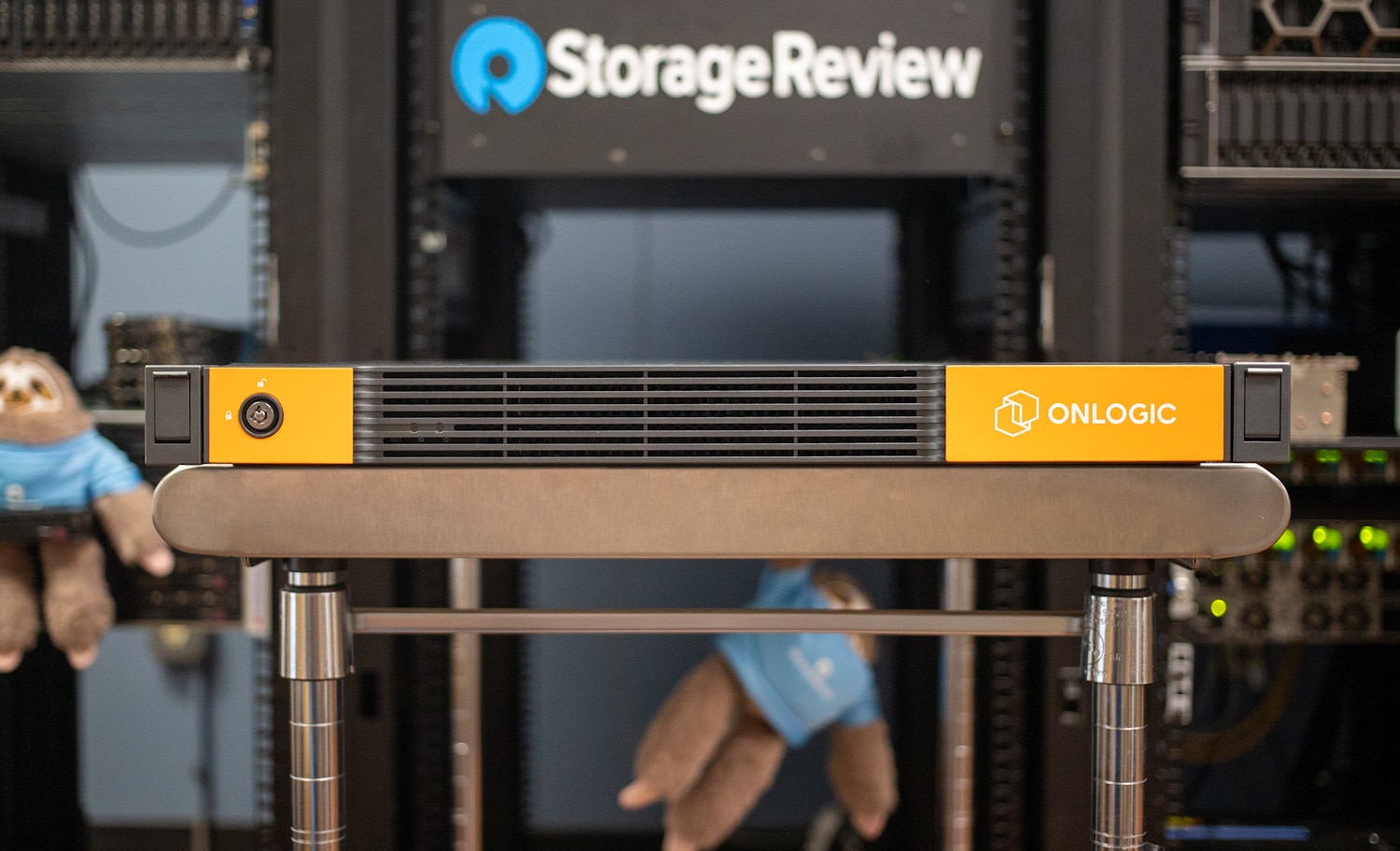
Onlogic is known for producing rugged industrial computers and tech solutions, which are built for the harshest of environments to provide high levels of reliability. Google, Amazon, and NASA are just a few companies that utilize OnLogic’s technology. This is our first time working with OnLogic on a review, so we are excited to see what they offer and how the OnLogic Axial AC101 holds up in our benchmarking.
As is the target for most edge servers these days, the OnLogic AC101 is a valuable tool that can help organizations with AI tasks like edge inferencing. Of course, it’s capable of many other applications like telco enablement, edge research, and the like. While overall a very small and cost-effective system, the AC101 still offers a lot of power and flexibility under the hood.
OnLogic Axial AC101
The AC101 interestingly uses a blend of consumer-grade parts with its industrial computer design. Getting into the specs, the system comes equipped with an Intel 13th Gen processor–up to an i9 24-core 32-thread option. For memory, it supports up to 4x DDR5-4800 UDIMMs (non-ECC or ECC) for a total of 128GB with 32GB DIMMS.
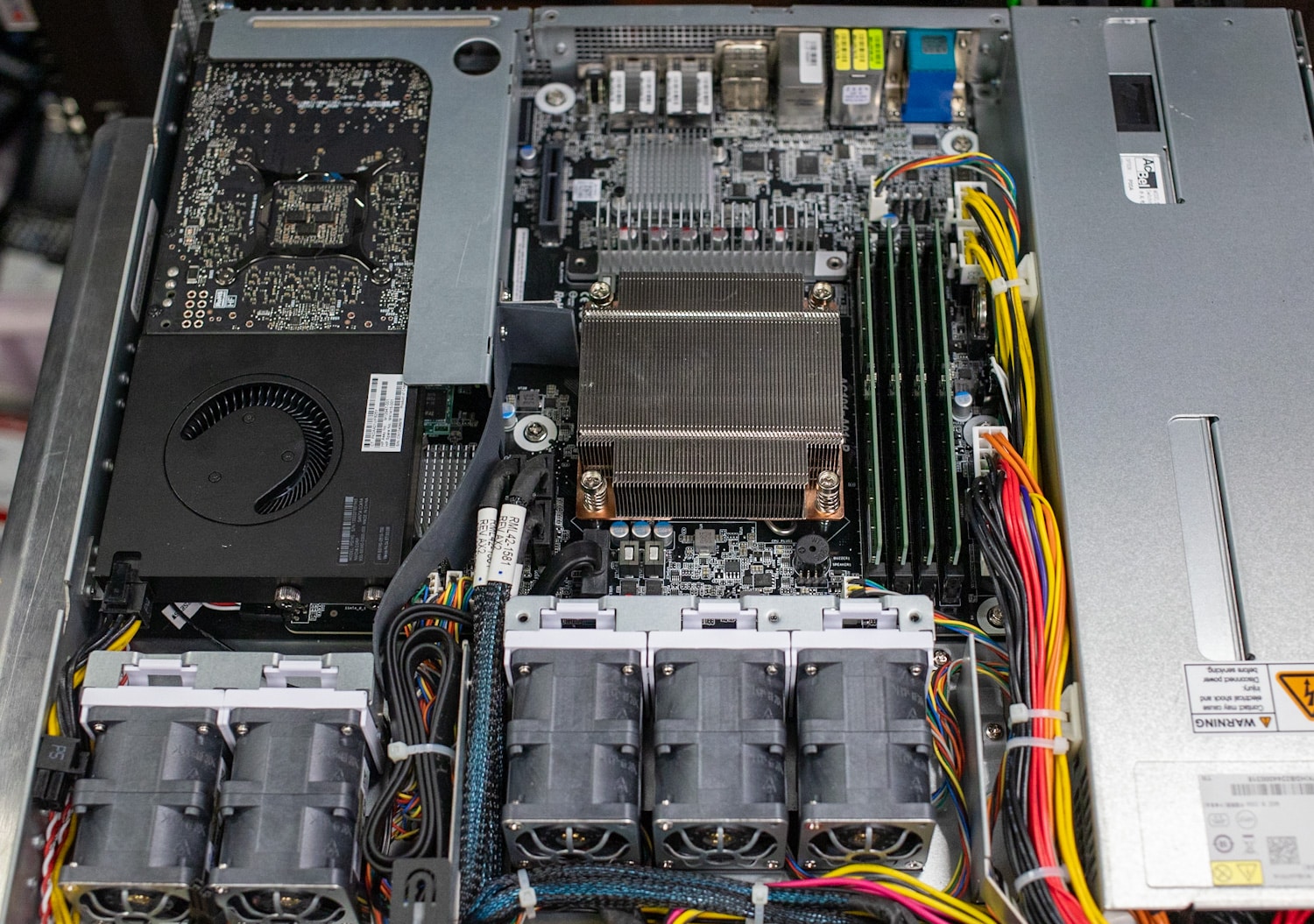
As indicated above, it also has an M.2 slot for a boot drive and four enterprise U.2 NMVe bays for storage. The review build has fou Micron 7450 Pro 960GB SSDs. It should be noted that these are internal to the chassis. Also in our configuration, its PCIe slot (for expansion) houses an NVIDIA A2 professional graphics card.
The Axial AC101 Edge Server has five 40x40x56mm counter-rotating system fans, which can be independently controlled and configured via the Baseboard Management Controller (BMC) relative to the supported system temperature sensors. Two fans are pointed at the PCIe slot, and three are for the SSDs and CPU.
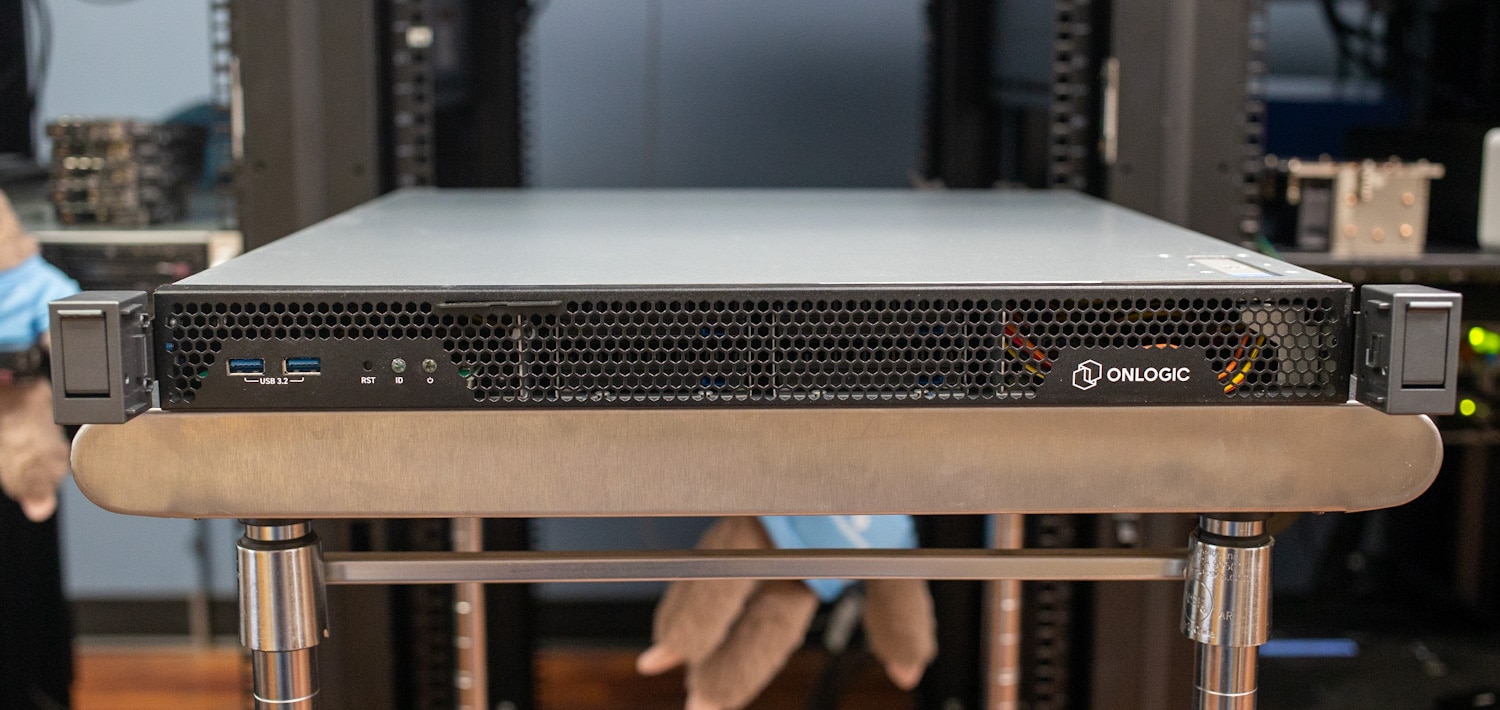
The PCIe riser card edge power draw of the slot is rated to support up to 75W as defined per PCI-SIG. PCIe adapters up to 150W are supported using the optional PCIe 6-Pin/8-Pin auxiliary power header.
The OnLogic Axial AC101 has a great range of I/O interface options to meet the diverse needs of edge computing tasks. On the front, as with all of their systems, the classic OnLogic orange color scheme is prevalent. Behind that, the server comes with 2x USB 3.2 Gen 1 Type-A ports. Our system came with the security bezel option, eliminating the 2 USB ports on the front. All AC101 systems have a white LED power button and a blue LED ID button.
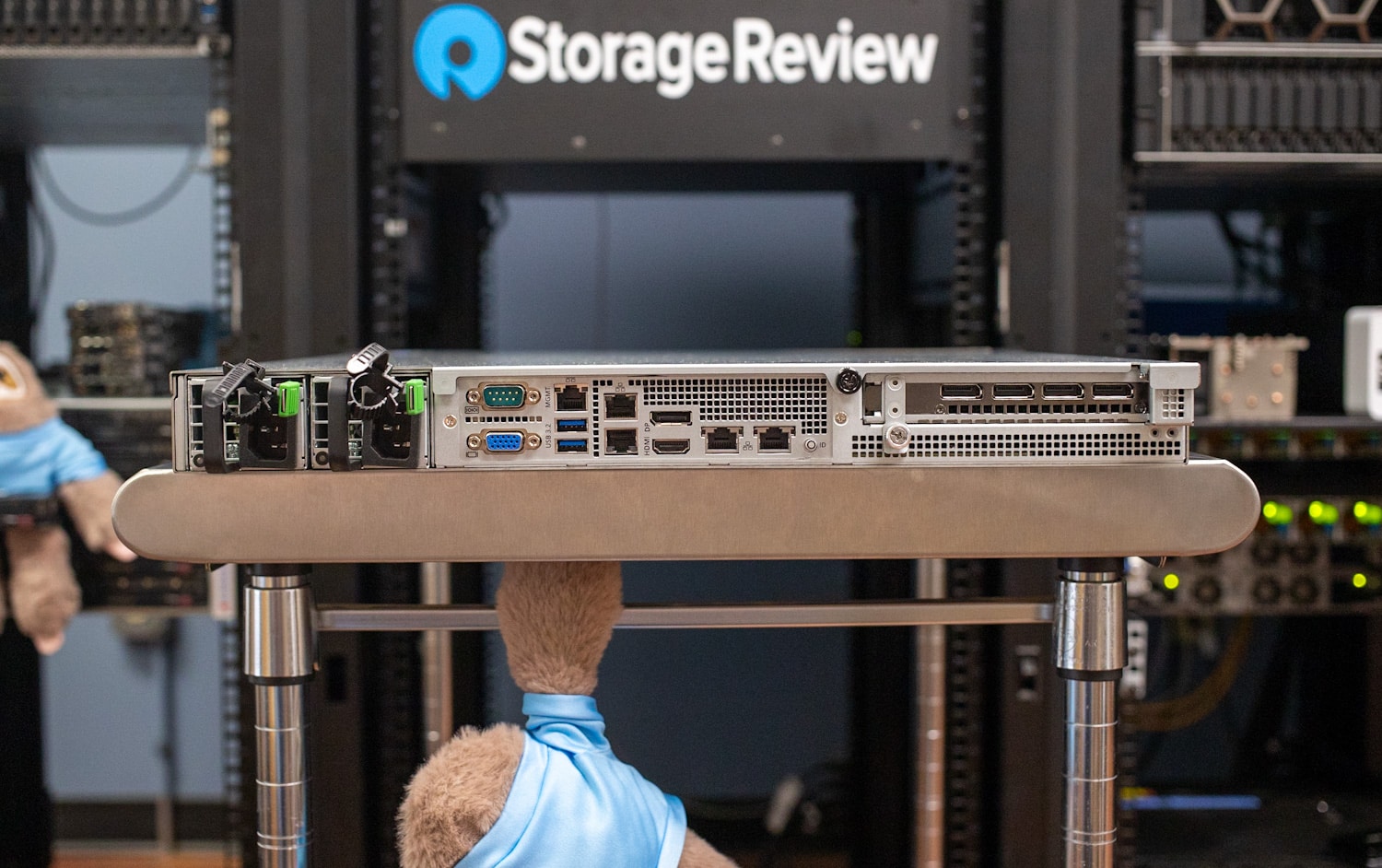
The bulk of ports are on the Rear I/O. For Ethernet connectivity, there are 2x 10GbE, 2x 1GbE, and 1x GbE dedicated management (BMC/IPMI) ports. On the back are two more USB 3.2 Gen 1 Type-A ports and a 1x DB9 (COM) serial port. It comes equipped with the usual DisplayPort, HDMI, and VGA connectors for display.
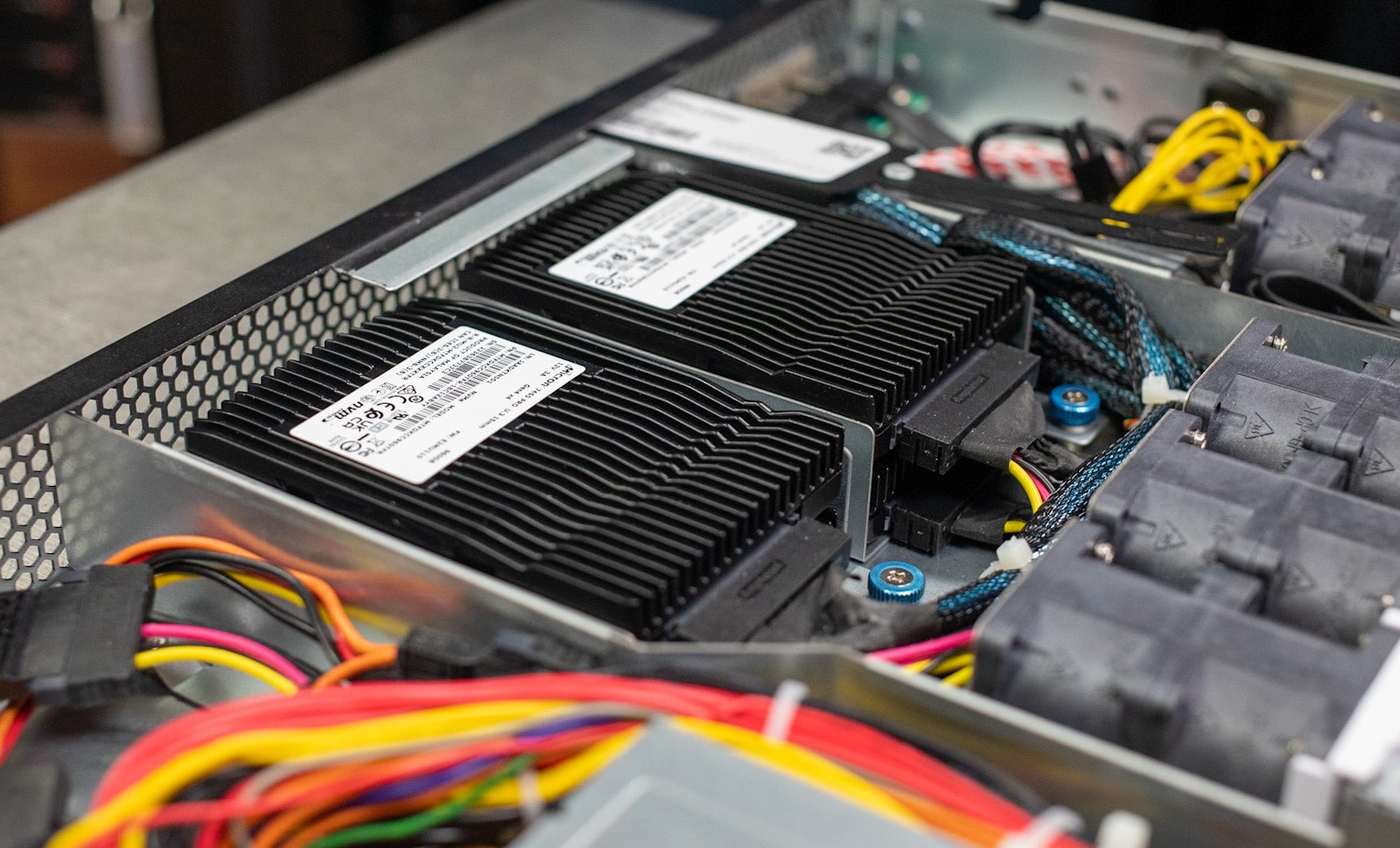
Also in the back are the power supplies. OnLogic offers single and dual PSU options, which go up to 750W. We have 2x 750 in our review unit.
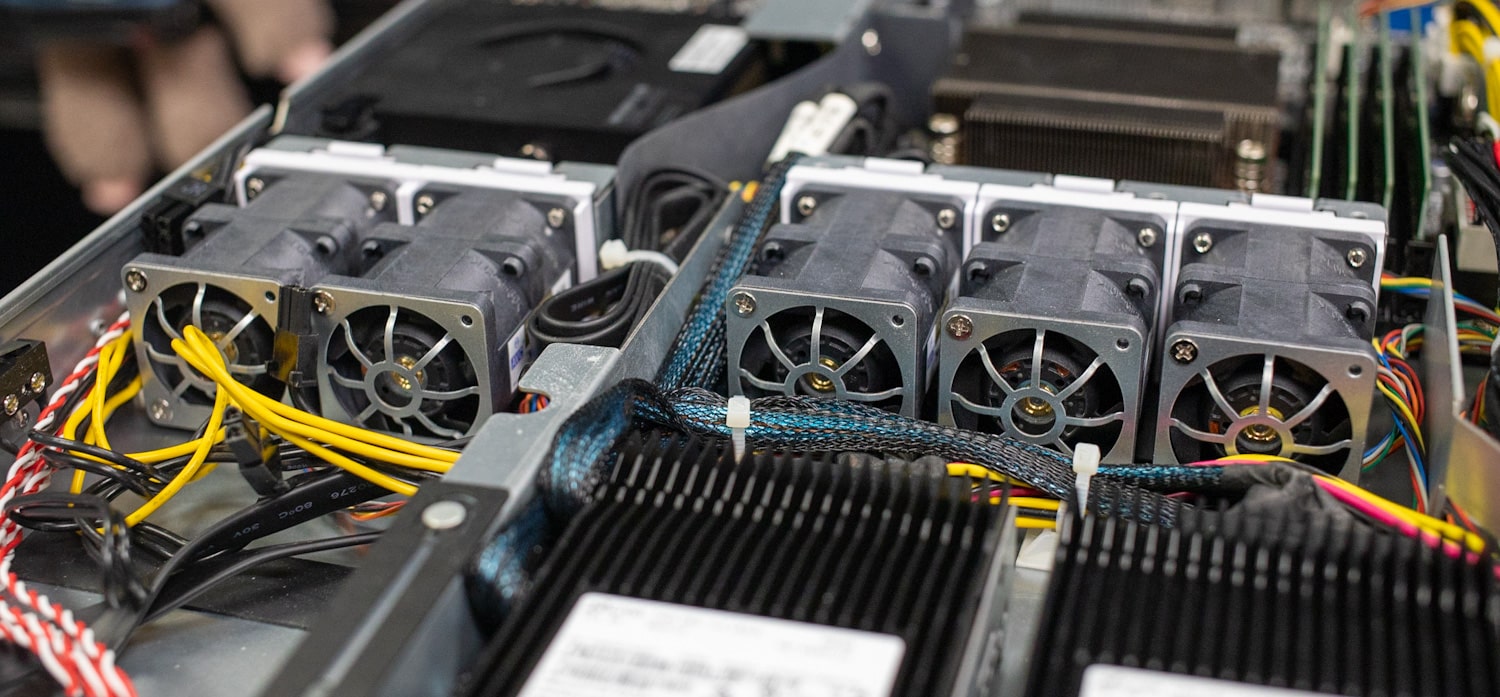
The system also has an intrusion detection switch, which many systems now use. This feature is commonly found in secure computing systems like rackmount servers and laptops. It works by triggering an alert if the physical case of the device is opened, signaling admins and users of potential unauthorized access. These alerts can prompt various automatic responses, such as system shutdowns or notifications to administrators.
The OnLogic Axial 100 Series is backed by a limited 2-year warranty.
OnLogic Axial 100 Series Specifications
| Category | Specification |
|---|---|
| Variants | AC101 – High-Performance 1U with 150W PCIe 4.0 x16 Expansion |
| Processor | Intel 13th Gen Raptor Lake-S (LGA1700) Core i3, i5, i7 & i9 up to 24-core 32-thread i3-13100E or TE, i5-13500E or TE, i7-13700E or TE, i9-13900E or TE 125W PL2 (Power Level 2) |
| Memory | Support up to 4x DDR5-4800 UDIMMs (non-ECC or ECC) Up to 128GB total memory Maximum operational speed: 4400 MT/s |
| Chipset | Intel W680 |
| Integrated Graphics | Intel UHD Graphics 730 (i3) or 770 (i5, i7, i9) |
| Front I/O | 2x USB 3.2 Gen 1 Type A 1x Power Button / LED (White) 1x ID button / LED (Blue) |
| Rear I/O | 1x 1GbE Dedicated Management (BMC/IPMI) 2x 1GbE LAN Intel i210 2x 10GbE LAN Intel X710 2x USB 3.2 Gen 1 Type-A 1x DisplayPort 1x HDMI 1x VGA 1x DB9 (COM) 1x ID button / LED (Blue) |
| Expansion & Storage | 1x M.2 2280/2260/2242/2230 M-key (PCIe Gen 3 x4) 1x PCIe Gen 4 x16 Full Height, Full Length slot (up to 150W) Up to 4x 2.5” Drives (NVMe or SATA) |
| Special Features | ASPEED AST2600: Full Web UI, iKVM, vMedia support 1/10 Network Controller Sideband Interface (NC-SI) Optional TPM 2.0 module (Infineon SLB9670) or Intel PTT (Native) Chassis Intrusion Detection Security Bezel Secure Boot |
| Operating Systems | Microsoft Windows 10 IoT Enterprise 2021 LTSC (Value/High End) 64-bit Microsoft Windows 11 Professional 64-bit |
| LAN Controllers | 2x Intel i210 Controllers (2x 1GbE ports) 1x Intel X710 Controller (2 x 10GbE ports) |
| Power Supplies | Up to 2 PSUs with PMBUS monitoring, 100~240 VAC input 450W Gold 750W Platinum |
| Dimensions (W x H x D) | 430 x 43.5 x 515mm (16.9 x 1.7 x 19.7”) without Security Bezel 483 x 43.5 x 534mm (19.0 x 1.7 x 21.0”) with Security Bezel |
| Weight | System Maximum: 10.02 kg (22.1 lbs) Shipping Maximum: 12.88 kg (28.4 lbs) |
| Mounting | Rack Mount 28” Toolless Slide Rail Rack Mount 23” Slide Rail Rack Mount 23” Slide Rail with Cable Management Arm Wall Mount |
| Operating Temperature | 5°C ~ 40°C (ASHRAE A3 Operating Temperature) Maximum ambient temperature decreases by 1°C for every 175m (574 ft) increase in altitude above 900m (2,953 ft) |
| Storage Temperature | -40°C ~ 70°C |
| Operating Humidity | 8~85% Relative, non-condensing Maximum dew point 24°C |
| Storage Humidity | 0~95% Relative, non-condensing Maximum dew point 24°C |
| Shock & Vibration | ISTA 6-FEDEX-A |
| Warranty | 2 Year Limited Warranty on parts and services |
| Extended Warranty Options | 3 and 5-year extensions available |
Performance
To demonstrate the capabilities of the OnLogic Axial AC101, we put it through a series of rigorous performance tests designed to gauge its competence in processing, graphics, and overall suitability for a diverse range of applications. As such, benchmarking includes SPECviewperf 2020, SPECworkstation 3, Blender OptiX, Luxmark, 7-Zip Compression, Blackmagic RAW Speed Test, and UL Procyon. We intend to shed light on its ability to handle tasks (spanning from graphics-intensive design to computational efficiency) so our readers can make an informed decision.
Our build has the following key specs:
| Component | Description |
|---|---|
| Processor | 1 x Intel Core i9-13900E Processor |
| Memory | 4 x Kingston DDR5-4800 32GB UDIMM w/ECC |
| Primary M.2 Storage | 1 x 512 GB M.2 NVMe SSD |
| PCIe Expansion Card | 1 x NVIDIA A2 16GB or NVIDIA A4000 |
| Additional Storage | 4 x Micron 7450 Pro 960GB U.3 2.5″ (1.0 DWPD) + Oculink to U.2 Cable |
| TPM 2.0 Module | 1 x ASRock Rack Infineon SLB9670 TPM 2.0 13-pin SPI Module |
| Power Supply | 1 x 750W Dual PSU with North American Power Cords |
| Operating System | 1 x Windows 11 Professional – 64 Bit |
| Auto Power On | 1 x Auto Power On |
| Mounting | 1 x 28″ Tool-less Ball Bearing Slide Rails |
In our testing, we used an NVIDIA A2 that shipped with the AC101 and an RTX A4000 that we had in the lab to profile two common rackmount workstations; an AI inferencing-focused build with the A2 and a more versatile graphical capable with the RTX4000.
OnLogic offers configuration from the factory of several GPU options including the NVIDIA T400, NVIDIA T1000, NVIDIA A2, and NVIDIA RTX A4000, as well as some other options for highspeed networking in place of a GPU including NVIDIA ConnectX-6LX 25GbE. Some of the tests that we utilize do not execute on the A2 GPU as well, including Procyon, so some of the tests are only with the RTX A4000 GPU. CPU-bound tests are not replicated through the GPU swap.
SPECviewperf 2020
Our first test is SPECviewperf 2020, the worldwide standard for measuring graphics performance of professional applications under the OpenGL and Direct X application programming interfaces. The viewsets (or benchmarks) represent graphics content and behavior from actual applications without having to install the applications themselves. The newest version of this benchmark went through significant updates late last year, including new viewsets taken from traces of the latest versions of 3ds Max, Catia, Maya, and Solidworks applications. In addition, they added support within all viewsets for both 2K and 4K resolution displays.
| SPECviewperf2020 Viewsets (Higher is better) |
OnLogic Axial 100 Series (Intel Core i9-13900E Processor, NVIDIA A4000) |
| 3dsmax-07 | 94.78 |
| Catia-06 | 70.54 |
| Creo-03 | 119.74 |
| Energy-03 | 22.43 |
| Maya-06 | 237.44 |
| Medical-03 | 21.86 |
| Snx-04 | 342.29 |
| Sw-05 | 111.93 |
Based on the SPECviewperf2020 benchmark results, the OnLogic Axial 100 Series showcases exceptional performance in various viewsets. Notably, it achieves impressive scores such as 237.44 in Maya-06, 342.29 in Snx-04, and 119.74 in Creo-03, reflecting its proficiency in handling demanding graphics tasks across design, engineering, and creative applications.
SPECworkstation 3
SPECworkstation3 specializes in benchmarks designed for testing all key aspects of workstation performance; it uses over 30 workloads to test CPU, graphics, I/O, and memory bandwidth. The workloads fall into broader categories such as Media and Entertainment, Financial Services, Product Development, Energy, Life Sciences, and General Operations. We will list the broad-category results for each instead of the individual workloads. The results are an average of all the individual workloads in each category.
| SPECworkstation 3 (Higher is better) |
OnLogic Axial 100 Series (Intel Core i9-13900E Processor, NVIDIA A4000) |
| Media and Entertainment | N/A |
| Product Development | 4.68 |
| Life Sciences | 4.22 |
| Financial Services | 5.28 |
| Energy | 4.86 |
| General Operations | 2.49 |
| GPU Compute | 0.34 |
The OnLogic Axial 100 Series delivered varying performance levels across different categories. Notably, it achieved competitive scores, such as 5.28 in Financial Services and 4.68 in Product Development, showcasing its proficiency in handling tasks related to financial calculations and product design. Additionally, the system’s scores of 4.22 in Life Sciences and 4.86 in Energy demonstrate its suitability for scientific and energy-related workloads. That said, it showed a modest score of 2.49 in General Operations, while its GPU Compute score of 0.34 suggests its limited performance in GPU-heavy computing tasks (which is due to the lower-end A2 professional graphics card).
Blender OptiX
Blender is an open-source 3D modeling application. This benchmark was run using the Blender Benchmark utility. The score is samples per minute, with higher being better. Here, we tested the OnLogic Axial with both the A2 and A4000 professional NVIDIA GPUs.
The NVIDIA A2 Tensor Core GPU is tailored for versatile entry-level inference tasks at the edge, offering low power consumption and a compact form factor. With features like low-profile PCIe Gen4 compatibility and a configurable 40-60W thermal design power (TDP), the A2 provides efficient inference acceleration for edge servers. The NVIDIA RTX A4000, on the other hand, is a more powerful single-slot GPU designed for professionals, offering real-time ray tracing, AI-accelerated compute, and high-performance graphics for desktop work.
| Blender OptiX (Samples per minute; Higher is better) | OnLogic Axial 100 Series (Intel Core i9-13900E Processor, NVIDIA A2 16GB) |
OnLogic Axial 100 Series (Intel Core i9-13900E Processor, NVIDIA A4000 16GB) |
| Monster | 480.73 | 1,154.3 |
| Junkshop | 303.33 | 619.98 |
| Classroom | 249.64 | 505.73 |
The results showcase a significant performance difference between the two GPUs. The NVIDIA A4000-equipped configuration outperforms the NVIDIA A2 configuration across all three benchmark scenes. This performance gap can be attributed to the NVIDIA A4000’s higher-end spec sheet, including its larger CUDA core count, higher memory bandwidth, and support for real-time ray tracing and AI-accelerated tasks.
Luxmark
Another 3D benchmark we will look at is LuxMark, an OpenCL GPU benchmarking utility.
| Luxmark (Higher is better) |
OnLogic Axial 100 Series (Intel Core i9-13900E Processor, NVIDIA A4000 16GB) |
| Hallbench | 14,029 |
| food | 5,612 |
Luxmark benchmark scores of 12,029 (hallbench) and 5,612 (food) are fairly solid decent.
7-Zip Compression
Our next test is the built-in memory benchmark in the popular 7-Zip utility. This test gauges the performance of the i9-13900E CPU and the OnLogic Axial 100’s memory by measuring the speed at which it can compress and decompress files using the 7-Zip compression software.
| 7-Zip Compression Benchmark (Higher is better) | OnLogic Axial 100 Series (Intel Core i9-13900E Processor, NVIDIA A4000 16GB) |
| Compressing | |
| Current CPU Usage | 1,580% |
| Current Rating/Usage | 6.795 GIPS |
| Current Rating | 107.343 GIPS |
| Resulting CPU Usage | 1,575% |
| Resulting Rating/Usage | 6.795 GIPS |
| Resulting Rating | 106.915 GIPS |
| Decompressing | |
| Current CPU Usage | 2,978% |
| Current Rating/Usage | 5.278 GIPS |
| Current Rating | 157.183 GIPS |
| Resulting CPU Usage | 2,929 % |
| Resulting Rating/Usage | 5.257 GIPS |
| Resulting Rating | 153.969 GIPS |
| Total Rating | |
| Total CPU Usage | 2,252% |
| Total Rating/Usage | 6.026 GIPS |
| Total Rating | 130.442 GIPS |
The 7-Zip compression benchmark results for the OnLogic Axial 100 Series highlight its solid computational performance. In the “Compressing” phase, the system achieves a resulting CPU usage of 1,575 percent, a resulting rating of 106.915 GIPS, and a resulting rating/usage of 6.795 GIPS. During the “Decompressing” phase, the system demonstrates a resulting CPU usage of 2,929 percent, a resulting rating of 153.969 GIPS, and a resulting rating/usage of 5.257 GIPS. The “Total Rating” phase showcases a total CPU usage of 2,252 percent, a total rating of 130.442 GIPS, and a total rating/usage of 6.026 GIPS. These results demonstrate the system’s capability to efficiently handle data compression and decompression tasks, such as data archiving, content creation, scientific computing, and cloud-edge environments (i.e., where quick processing and efficient storage are essential).
Blackmagic RAW Speed Test
Our last test is the new Blackmagic RAW Speed Test. OnLogic Axial 100 Series scored the following when outfitted with the NVIDIA A4000.
| OnLogic Axial 100 Series (Intel Core i9-13900E Processor, NVIDIA A4000) |
|
| 8K CPU | 83 fps |
| 8K OPENCL | 58 fps |
UL Procyon Test
The UL Procyon test is an important evaluation tool, measuring the average inference time for various well-known models across different tasks.
Here, we put it through two different versions: One that uses AIWinML, which focuses on CPU-based performance evaluation for the specified models or tasks, and one that leverages AITensorRT, which focuses on assessing model performance using an NVIDIA A4000 GPU for acceleration.
| AITensorRT | |
| Model | Average Inference Time (ms) |
| MobileNet V3 | 1.41 |
| ResNet 50 | 12.16 |
| Inception V4 | 36.50 |
| DeepLab V3 | 36.89 |
| YOLO V3 | 78.07 |
| REAL-ESRGAN | 3,655.91 |
| Overall score | 810 |
The UL Procyon results yield interesting insights into model performance. For example, the MobileNet V3 and ResNet 50 show impressive inference times of 1.41ms and 12.16ms, respectively, demonstrating a balance of speed and accuracy. More intricate models like Inception V4, DeepLab V3, and YOLO V3 have higher inference times (between 36-78ms), while REAL-ESRGAN’s 3,655.91ms suggests its resource-intensive image enhancement capabilities. Its overall score is a solid 810.
Next up is the AIWinML version of the UL Procyon test:
| Model | Average Inference Time (ms) |
| MobileNet V3 | 1.41 |
| ResNet 50 | 12.16 |
| Inception V4 | 36.50 |
| DeepLab V3 | 36.89 |
| YOLO V3 | 78.07 |
| REAL-ESRGAN | 3,655.91 |
| Overall Score | 115 |
These results highlight MobileNet V3 and ResNet 50 with inference times of 1.41ms and 12.16ms. More complex models like Inception V4, DeepLab V3, and YOLO V3 show slightly higher inference times (around 36-78ms). The REAL-ESRGAN model had an inference time of 3,655.91ms.
Conclusion
The OnLogic Axial AC101 1U rackmount server is a solid release by the company, highlighting its commitment to delivering robust industrial computing solutions. This versatile system, powered by an Intel 13th-Gen Raptor Lake processor, boasts a range of capabilities catering to various tasks, including edge inferencing, telco enablement, and edge research. Blending consumer-grade components with industrial design, the AC101 offers power and flexibility, with options up to an Intel Core i9 24-core 32-thread processor and support for up to 128GB of DDR5-4800 memory.
The AC101’s strategic design extends to its storage capabilities, featuring an M.2 slot for boot drives and four U.2 NVMe bays for ample storage space. In addition, the system’s PCIe expansion slot accommodates additional I/O options or a low-power GPU such as the NVIDIA A2/L4, enhancing its versatility for various applications. The onboard twin 10GbE and out-of-band management support further highlight its enterprise-grade capabilities.
OnLogic’s reputation for producing quality industrial-grade technology shows with the Axial AC101, positioning it as an ideal choice for organizations requiring reliability and performance in demanding environments. With its array of I/O interface options, including 10GbE, 1GbE, USB 3.2 Gen 1, and display connectivity, the AC101 proves its capability to address a spectrum of connectivity needs. Including security features like intrusion detection and secure boot further emphasizes its commitment to data protection.
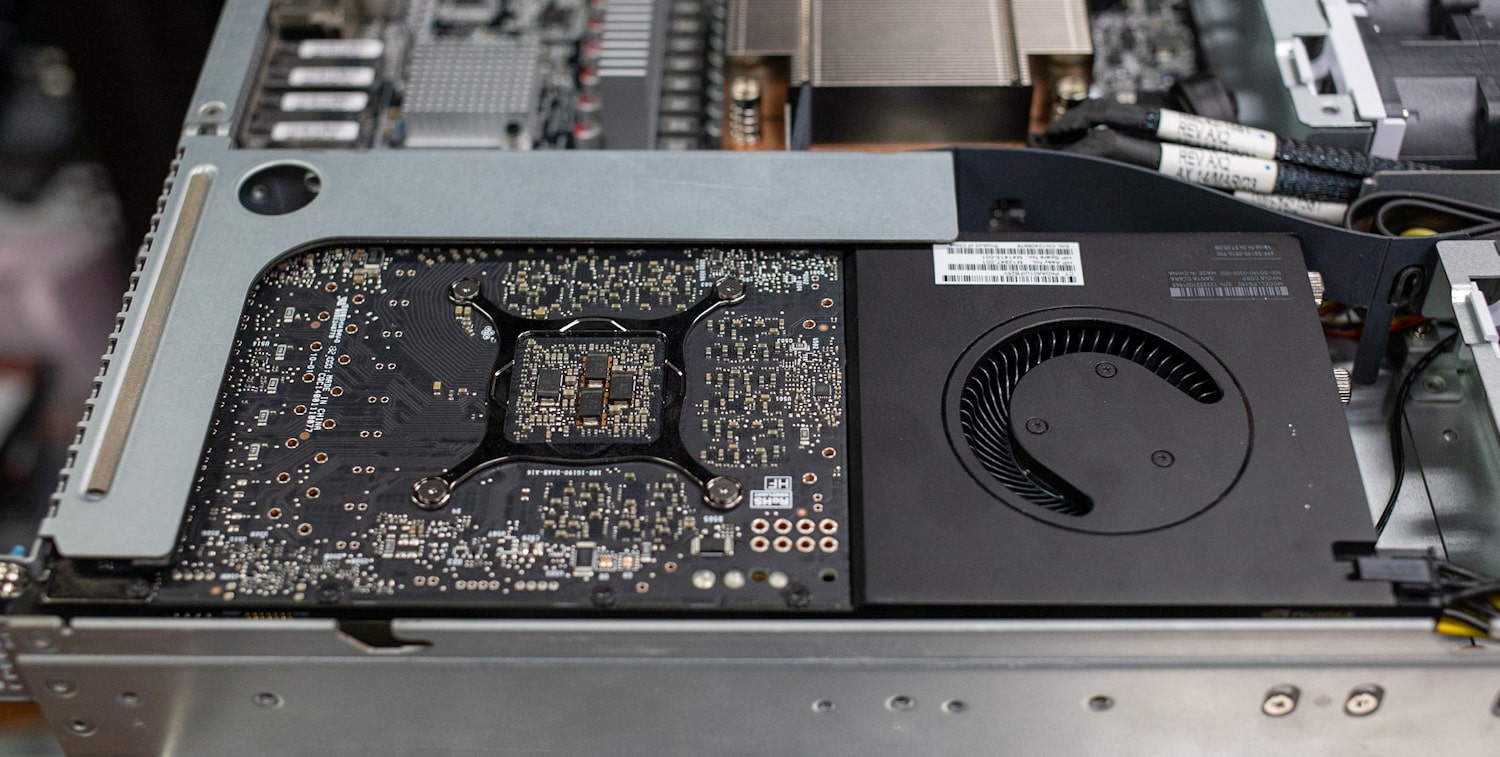
As far as its performance goes, the OnLogic Axial AC101 delivered exceptional results across a range of benchmarks when outfitted with an Intel Core i9-13900E Processor and NVIDIA A2 16GB graphics card (we also installed an NVIDIA A4000 for some of the tests). Notable highlights include its proficiency in handling demanding graphics tasks, as demonstrated by impressive scores like 237.44 in Maya-06 and 342.29 in Snx-04 in the SPECviewperf 2020 benchmark. The system also showcases competitive performance in various other categories, with scores of 5.28 in Financial Services and 4.68 in Product Development in the SPECworkstation 3 benchmark. It also performed well in rendering tasks, as indicated by the Blender OptiX results (As we expected, the NVIDIA A4000 GPU outperforms the A2 configuration in rendering tasks by roughly 70-80%).
The OnLogic Axial AC101 stands out as a cost-effective edge server solution that successfully blends compactness with power-driven capabilities, aligning well with the demands of edge computing requirements. Whether deployed for inferencing, telco tasks, or beyond, the AC101 is a versatile and reliable tool and we look forward to seeing them more often in our lab.




 Amazon
Amazon